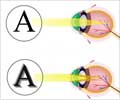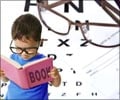About
Amblyopia, or ‘lazy eye’ is the loss of one eye's ability to see details due to poor development of central vision.
It affects just 2-3% of the population. The eye is anatomically normal, but visual acuity is reduced even with glasses. Amblyopia is the commonest cause of vision problems in children, and develops sometime between birth and 8 or 9 years of age, the critical period of time when the visual system develops and matures. Amblyopia causes more visual loss in the age group under 40 than all the injuries and diseases combined.

Amblyopia occurs when the nerve connections between the brain and the eye fail to develop normally. Vision problems such as short sightedness, long sightedness or astigmatism, if uncorrected can cause
The amblyopic eye may develop a permanent visual defect and depth perception (seeing in three dimensions) may be lost. If the stronger eye becomes diseased or injured, it can mean a lifetime of
Regular eye checkup in children below the age of 6 years can detect and prevent amblyopia.
Early detection of the condition increases the chance of successful treatment, especially if it is detected before the age of five.
The treatment of amblyopia aims at equalizing vision between the two eyes. This can be done by wearing corrective glasses, eye exercises or surgery. Amblyopia will not go away on its own, and an untreated amblyopia can lead to permanent visual problems and poor depth perception.














